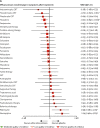Comparative efficacy and acceptability of antidepressants, psychotherapies, and their combination for acute treatment of children and adolescents with depressive disorder: a systematic review and network meta-analysis
- PMID: 32563306
- PMCID: PMC7303954
- DOI: 10.1016/S2215-0366(20)30137-1
Comparative efficacy and acceptability of antidepressants, psychotherapies, and their combination for acute treatment of children and adolescents with depressive disorder: a systematic review and network meta-analysis
Abstract
Background: Depressive disorders are common in children and adolescents. Antidepressants, psychotherapies, and their combination are often used in routine clinical practice; however, available evidence on the comparative efficacy and safety of these interventions is inconclusive. Therefore, we sought to compare and rank all available treatment interventions for the acute treatment of depressive disorders in children and adolescents.
Methods: We did a systematic review and network meta-analysis. We searched PubMed, Embase, the Cochrane Central Register of Controlled Trials, Web of Science, PsycINFO, ProQuest, CINAHL, LiLACS, international trial registries, and the websites of regulatory agencies for published and unpublished randomised controlled trials from database inception until Jan 1, 2019. We included placebo-controlled and head-to-head trials of 16 antidepressants, seven psychotherapies, and five combinations of antidepressant and psychotherapy that are used for the acute treatment of children and adolescents (≤18 years old and of both sexes) with depressive disorder diagnosed according to standard operationalised criteria. Trials recruiting participants with treatment-resistant depression, bipolar disorder, psychotic depression, treatment duration of less than 4 weeks, or an overall sample size of fewer than ten patients were excluded. We extracted data following a predefined hierarchy of outcome measures, and assessed risk of bias and certainty of evidence using validated methods. Primary outcomes were efficacy (change in depressive symptoms) and acceptability (treatment discontinuation due to any cause). We estimated summary standardised mean differences (SMDs) or odds ratios (ORs) with credible intervals (CrIs) using network meta-analysis with random effects. This study was registered with PROSPERO, number CRD42015020841.
Findings: From 20 366 publications, we included 71 trials (9510 participants). Depressive disorders in most studies were moderate to severe. In terms of efficacy, fluoxetine plus cognitive behavioural therapy (CBT) was more effective than CBT alone (-0·78, 95% CrI -1·55 to -0·01) and psychodynamic therapy (-1·14, -2·20 to -0·08), but not more effective than fluoxetine alone (-0·22, -0·86 to 0·42). No pharmacotherapy alone was more effective than psychotherapy alone. Only fluoxetine plus CBT and fluoxetine were significantly more effective than pill placebo or psychological controls (SMDs ranged from -1·73 to -0·51); and only interpersonal therapy was more effective than all psychological controls (-1·37 to -0·66). Nortriptyline (SMDs ranged from 1·04 to 2·22) and waiting list (SMDs ranged from 0·67 to 2·08) were less effective than most active interventions. In terms of acceptability, nefazodone and fluoxetine were associated with fewer dropouts than sertraline, imipramine, and desipramine (ORs ranged from 0·17 to 0·50); imipramine was associated with more dropouts than pill placebo, desvenlafaxine, fluoxetine plus CBT, and vilazodone (2·51 to 5·06). Most of the results were rated as "low" to "very low" in terms of confidence of evidence according to Confidence In Network Meta-Analysis.
Interpretation: Despite the scarcity of high-quality evidence, fluoxetine (alone or in combination with CBT) seems to be the best choice for the acute treatment of moderate-to-severe depressive disorder in children and adolescents. However, the effects of these interventions might vary between individuals, so patients, carers, and clinicians should carefully balance the risk-benefit profile of efficacy, acceptability, and suicide risk of all active interventions in young patients with depression on a case-by-case basis.
Funding: National Key Research and Development Program of China.
Copyright © 2020 Elsevier Ltd. All rights reserved.
Figures








Comment in
-
Identifying the best treatment for young people with depression.Lancet Psychiatry. 2020 Jul;7(7):562-563. doi: 10.1016/S2215-0366(20)30236-4. Lancet Psychiatry. 2020. PMID: 32563296 Free PMC article. No abstract available.
-
Treatment of depression in children and adolescents.Lancet Psychiatry. 2021 Feb;8(2):96-97. doi: 10.1016/S2215-0366(20)30492-2. Lancet Psychiatry. 2021. PMID: 33485417 No abstract available.
-
Treatment of depression in children and adolescents - Authors' reply.Lancet Psychiatry. 2021 Feb;8(2):97-98. doi: 10.1016/S2215-0366(20)30537-X. Lancet Psychiatry. 2021. PMID: 33485418 No abstract available.
-
Treatment of depression in children and adolescents.Lancet Psychiatry. 2021 Feb;8(2):97. doi: 10.1016/S2215-0366(20)30518-6. Lancet Psychiatry. 2021. PMID: 33485419 No abstract available.
References
-
- Mokdad AH, Forouzanfar MH, Daoud F. Global burden of diseases, injuries, and risk factors for young people's health during 1990-2013: a systematic analysis for the Global Burden of Disease Study 2013. Lancet. 2016;387:2383–2401. - PubMed
-
- Sadler K, Vizard T, Ford T. NHS Digital; 2018. Mental health of children and young people in England, 2017: summary of key findings.https://digital.nhs.uk/data-and-information/publications/statistical/men...
-
- Ryan ND. Treatment of depression in children and adolescents. Lancet. 2005;366:933–940. - PubMed
-
- Hopkins K, Crosland P, Elliott N, Bewley S. Diagnosis and management of depression in children and young people: summary of updated NICE guidance. BMJ. 2015;350:h824. - PubMed
Publication types
MeSH terms
Substances
LinkOut - more resources
Full Text Sources
Medical

